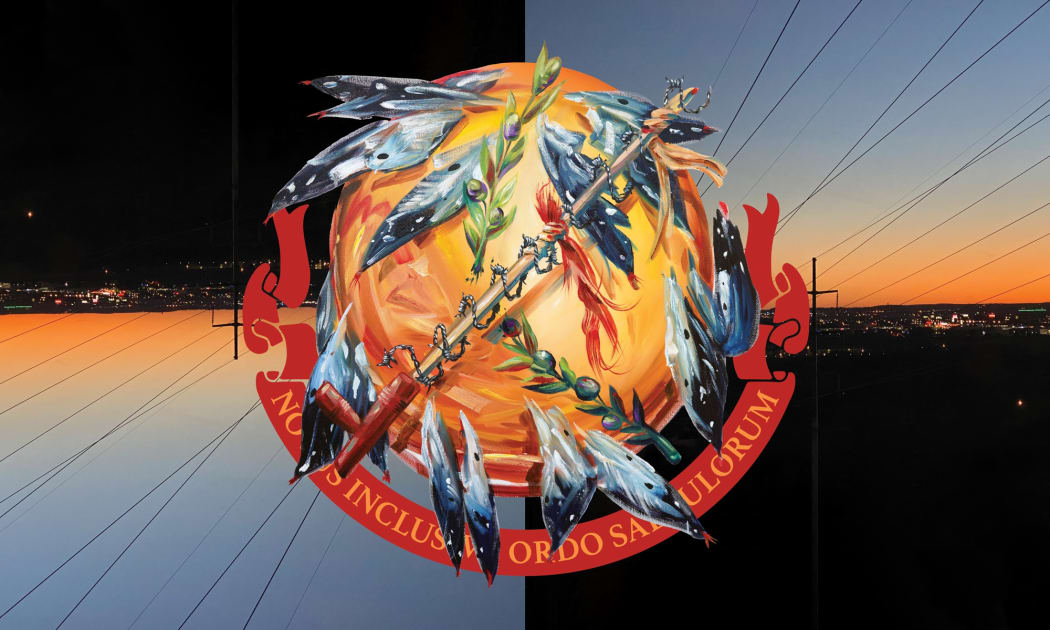
form & concept and Zane Bennett Contemporary Art are proud to announce a new edition of Flags of Resilience, a long-term, artist-run project featuring commissioned work by local and internationally-known artists in response to their unique and communal experiences amid global upheaval. The series of original flag artworks continues with a new design by Tulsa-based Native artist Yatika Starr Fields, and will benefit the National Indigenous Women’s Resource Center (NIWRC).
For his flag design, Fields reinvents and imagines his home state’s 1925 flag depiction of the Osage Nation shield, with a special emphasis on Native rights and inclusivity. Read more on the original art inspiration and messaging from the artist below. Support the artist and their chosen cause by acquiring a flag today!

yatika fields: flags of resilience statement
In our reckoning of 2020, we surmise what we felt as a nightmare, only to be confronted with a dead reality and truths of a country fabricated by inaccuracies and wrongdoings.
With our health in jeopardy and the perils of COVID-19 flanking our mental, physical and social identities, we have become accustomed to the new normal in practices. We identify more with political affiliations and seek to clarify our state’s role in mandates and treatment of communities of color, and also hold accountability in our own actions and of others, or seek to find and share a same alliance.
2020 was a year that was needed to open a wound that was provoked, premeditated—an inflection of genocide. We now have a chance to operate and clean its origins, past and present, that laments the hollow sutures of goodwill.
Flags are emblematic connotations to identities, a social crest to state and country. They derive, with colonial overtones usually, from the makers within the perimeters of the state's appraised history. Just recently Massachusetts changed the state flag as it was a symbol of violence that had many points of oppression in exaggerated symbolism; it had reigned since 1898 over the commonwealth in subtle oppressions of native histories in New England.
My flag design derives from the lands I am from and the state that’s come to be: Oklahoma, a place of agriculture, oil and histories, Route 66, and the expansion of the west for commerce and capitol. A landscape that once held great plains ecosystems sustaining indigenous people, landscape and bison now replaced with cattle, farming and a construct of property and boundaries in all accord to wealth. Sprawling urban developments linked by wires, landscapes in grids are terrains we all aspire in.
It’s similar in all the states and countries in regards to symbolism. I can’t speak for all but can only share my experiences from my place and knowledge.
In response to the request of participating in Flags of Resilience, I wanted to recreate what was created in 1925 to represent Oklahoma through a contest to show the diversity of cultures and peace of European and Indigenous relations. An Osage shield was selected as the central symbol in the contest and other symbols taken from past, Choctaw Blue, pipe and the olive branch—all to symbolize something that is not so true.
As an Osage artist, an Indigenous person, I wanted to have agency over this shield where I see it being used as a symbol of contradiction in many ways.
I’ve taken the motto “Novus Ordo Seclorum” (New Order of the Ages), that of which is on the great seal of the United States, and changed it into “Novus inclusive ordo Saeculorum,” meaning “the new inclusive ages, new inclusive world order” but with inclusive to all and new.
Yatika Fields, Flags of Resilience, February Edition art
As we move forward in 2021, I want this country to be mindful, to be held accountable for the past and be receptive to the changes that are needed. That is, to be inclusive of all people, backgrounds and genders.
The final details to the flag are upon the pipe. I’ve painted a more traditional adorned Osage pipe. I incorporated barbed wire wrapping around it as a symbol of protection. We have always had to fight and protect our beliefs to practice under the watchful eyes of the government—even when tribal sovereignty is in place. Policies and interims in regulations on gaming and environmental protection plans on our lands are in a constant stress of protection. It’s a double meaning as some sacred lands have been taken from us and fenced in—we are banished in our own ancestral lands.
The final tone to the flag is the sunset. Oklahoma has some of the most magnificent sunsets I’ve ever witnessed. The landscape sprawled beneath is a rich layer of urban lights, telephone wires and the poles that produce a metaphor and symbol of their own to the creation stories, crosses and stars that are seen in about every flag in the world. The rich darkness that fades on both corners are a symbol of the old Osages and warrior tactics to go along with the war shield, of fire and destructive strengths.
Prior to this project and the past year, I have noticed flags in a new light, mostly through their use by right wing militants: Trump flags emblazoned with hate and “blue lives matter” flags. Flags decide identity; they come and go just as the fragility of our lands and lives. I think it’s necessary to revisit each state flag and discuss its meanings. Does it work for all in the state?
This Flag is for all; it’s meant to protect all under the sanctity of the shield and the duties that are within the warrior’s codes. The landscape is a reality of our lives and connections. The sunset is the movement of the day into the next with hope and awestruck inspiration. We have to protect what’s sacred for us.
Learn more about Flags of Resilience.
